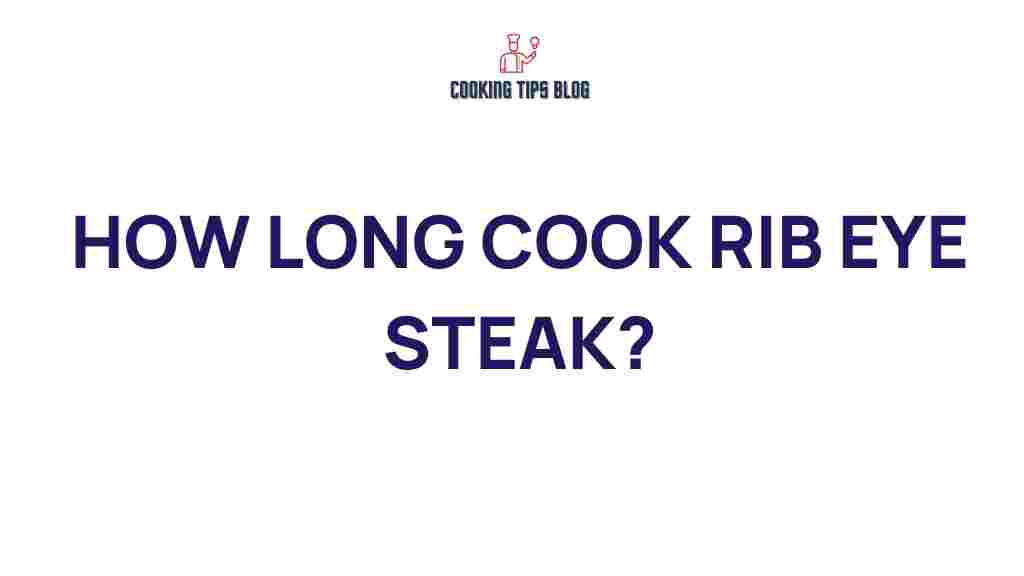Unlocking the Perfect Rib Eye Steak: Cooking Time Secrets Revealed
The rib eye steak is known for its rich flavor and tenderness, making it a favorite choice for meat lovers. However, achieving the perfect rib eye steak can be a daunting task for many home cooks. The key to mastering this delicious cut lies not only in selecting the best quality meat but also in understanding the cooking times and techniques that can elevate your dish.
In this article, we’ll delve into the secrets of cooking rib eye steak to perfection. From selecting the right cut to troubleshooting common issues, you will gain the knowledge needed to impress your family and friends at your next dinner gathering.
Understanding Rib Eye Steak
Before we dive into cooking techniques, it’s essential to understand what makes rib eye steak so special. Rib eye steak is cut from the rib section of the cow and is well-marbled with fat, which contributes to its rich flavor and tenderness. This marbling allows the steak to remain juicy during cooking, making it ideal for grilling, pan-searing, or even broiling.
Choosing the Right Rib Eye Steak
When selecting rib eye steak, consider the following factors:
- Grade: Look for USDA Prime or Choice grades for the best quality. Prime has the highest marbling, while Choice offers a balance of quality and affordability.
- Thickness: A thicker steak (1.5 to 2 inches) is ideal for achieving a perfect sear while keeping the inside tender and juicy.
- Bone-in vs. Boneless: Bone-in rib eye steaks (also known as ribeye or cowboy steaks) offer more flavor, while boneless options are easier to handle.
Preparing Rib Eye Steak for Cooking
Once you have selected your rib eye steak, it’s time to prepare it for cooking. Here are the essential steps:
1. Bring to Room Temperature
Before cooking, allow your rib eye steak to sit at room temperature for about 30 to 60 minutes. This ensures even cooking throughout the steak.
2. Season Generously
Use a generous amount of salt and freshly ground black pepper to season your rib eye steak. You can also add garlic powder, onion powder, or your favorite steak rub for additional flavor.
3. Preheat Your Cooking Surface
Whether you’re grilling or pan-searing, make sure to preheat your cooking surface. For grilling, aim for a high heat, while for pan-searing, use a cast-iron skillet heated over medium-high heat.
Cooking Rib Eye Steak: Time Secrets Revealed
The cooking time for rib eye steak largely depends on its thickness, your desired doneness, and the cooking method used. Here’s a quick guide for grilling and pan-searing:
Grilling Rib Eye Steak
For a perfectly grilled rib eye steak, follow these steps:
- Rare: 120°F (49°C) – 4 to 5 minutes per side
- Medium Rare: 130°F (54°C) – 5 to 6 minutes per side
- Medium: 140°F (60°C) – 6 to 7 minutes per side
- Medium Well: 150°F (66°C) – 7 to 8 minutes per side
- Well Done: 160°F (71°C) and above – 8 to 9 minutes per side
Use a meat thermometer to check the internal temperature accurately.
Pan-Seared Rib Eye Steak
For pan-searing, follow these steps:
- Rare: 120°F (49°C) – 3 to 4 minutes per side
- Medium Rare: 130°F (54°C) – 4 to 5 minutes per side
- Medium: 140°F (60°C) – 5 to 6 minutes per side
- Medium Well: 150°F (66°C) – 6 to 7 minutes per side
- Well Done: 160°F (71°C) and above – 7 to 8 minutes per side
For added flavor, consider basting your steak with butter, garlic, and herbs during the last few minutes of cooking.
Resting Your Rib Eye Steak
After cooking, it’s crucial to let your rib eye steak rest for about 5 to 10 minutes. This allows the juices to redistribute throughout the meat, ensuring a juicy and flavorful bite.
Troubleshooting Common Rib Eye Steak Issues
Even with the best preparation, you might encounter some common issues when cooking rib eye steak. Here are a few troubleshooting tips:
1. Steak is Too Tough
If your rib eye steak turns out tough, it might be due to overcooking or a low-quality cut. Always choose a high-grade steak and watch the cooking time closely.
2. Steak is Too Salty
If you’ve over-seasoned your steak, try balancing it out by serving it with a mild side dish like mashed potatoes or steamed vegetables.
3. Steak Lacks Flavor
If your steak lacks flavor, consider marinating it for a few hours before cooking or using a robust seasoning blend.
4. Uneven Cooking
To avoid uneven cooking, ensure that your steak is of uniform thickness and that you allow it to come to room temperature before cooking.
Conclusion: Enjoying the Perfect Rib Eye Steak
Cooking the perfect rib eye steak is an art that requires attention to detail and a little practice. By understanding the key factors such as selecting quality meat, mastering cooking times, and troubleshooting common issues, you can unlock the secrets to delicious rib eye steak at home.
Next time you fire up the grill or heat your skillet, remember these tips and enjoy a mouthwatering rib eye steak that will have everyone asking for seconds.
For more tips on cooking meats, check out our detailed guide on meat preparation techniques. And if you’re looking for high-quality rib eye steak, consider visiting your local butcher or checking reputable online suppliers at trusted meat sources.
This article is in the category Recipes and created by Cookingtipsblog Team
